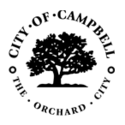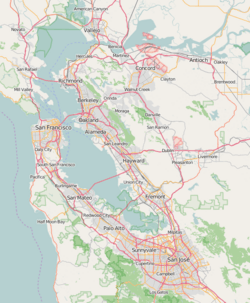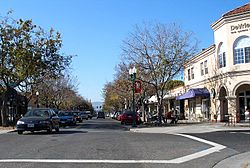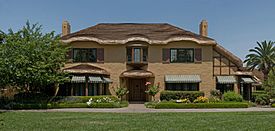Campbell, California facts for kids
Quick facts for kids
Campbell, California
|
|||
|---|---|---|---|
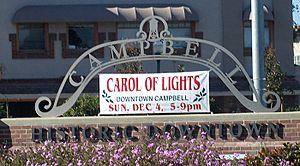
Campbell's welcome sign
|
|||
|
|||
| Motto(s):
The Orchard City
|
|||

Location of Campbell in Santa Clara County, California
|
|||
| Country | United States | ||
| State | California | ||
| County | Santa Clara | ||
| Incorporated | March 28, 1952 | ||
| Government | |||
| • Type | Council-Manager | ||
| Area | |||
| • Land | 6.35 sq mi (16.4 km2) | ||
| Elevation | 200 ft (61 m) | ||
| Population
(2020)
|
|||
| • Total | 43,959 | ||
| • Density | 7,228.91/sq mi (2,791.25/km2) | ||
| Time zone | UTC−8 (Pacific) | ||
| • Summer (DST) | UTC−7 (PDT) | ||
| ZIP codes |
95008, 95009, 95011
|
||
| Area codes | 408/669 | ||
| FIPS code | 06-10345 | ||
| GNIS feature IDs | 277483, 2409971 | ||
Campbell is a city in Santa Clara County, California. It is located in the San Francisco Bay Area. In 2020, about 43,959 people lived there.
Campbell is known for the Pruneyard Shopping Center. This large outdoor shopping area was part of an important U.S. Supreme Court case. The case helped decide how much free speech people have in California. Today, the Pruneyard Shopping Center is home to the local offices of the Federal Bureau of Investigation (FBI).
| Top - 0-9 A B C D E F G H I J K L M N O P Q R S T U V W X Y Z |
History of Campbell, California
Early Days and Founding
Before Campbell was founded, the land was home to the Ohlone people. They are Native Americans from the Northern California coast.
Later, some of the land became part of a large land grant in 1839. This grant was called Rancho Rinconada de Los Gatos.
How Campbell Grew
The city was named after Benjamin Campbell (1826–1907). He came to California in 1846 with his father. In 1851, Benjamin bought 160 acres (0.65 km2) of land. He grew hay and grain there. This area later became Campbell's downtown.
In 1878, Campbell sold his land to a railroad company. By 1887, the first part of the town was officially planned. Benjamin and his wife, Mary Campbell, founded the city. It was first called Campbell's Place. Later, it became the town of Campbell.
In 1888, the Campbell School District was started.
The area became a hub for shipping fruit. Fruit was grown in the fields around the town. Soon, places for drying fruit and canneries (factories that preserve food in cans) made Campbell an important train center. By 1892, the Campbell Fruit Growers' Union was a well-known group. They had a 17-acre (69,000 m2) drying yard.
In 1895, The Bank of Campbell was founded. The first newspaper, the Campbell Weekly Visitor, also began.
Campbell officially became a city in 1952. The city grew quickly as fruit orchards were replaced by new homes. Today, Campbell is a residential area in the southern Santa Clara Valley.
Geography of Campbell
Campbell is surrounded by other cities. San Jose is to its east and north. Los Gatos is to the south. A small part of Saratoga is to the west.
The city covers about 5.9 square miles (15 km2). Most of this is land, with a small amount of water. The water includes ponds in Los Gatos Creek Park. There are also two creeks: San Tomas Aquino Creek and Los Gatos Creek. Paths along Los Gatos Creek are popular for walking and jogging.
Downtown Campbell has many local shops and stores. Every Sunday, the downtown street closes for a farmers market.
Major roads near Campbell include State Route 17 and State Route 85.
Population and People
| Historical population | |||
|---|---|---|---|
| Census | Pop. | %± | |
| 1960 | 11,863 | — | |
| 1970 | 23,797 | 100.6% | |
| 1980 | 26,843 | 12.8% | |
| 1990 | 36,048 | 34.3% | |
| 2000 | 38,138 | 5.8% | |
| 2010 | 39,349 | 3.2% | |
| 2020 | 43,959 | 11.7% | |
| U.S. Decennial Census | |||
Campbell's Population in 2020
In 2020, Campbell had a population of 43,959 people.
- About 59.7% of the people were White.
- About 23.6% were Asian.
- About 19.7% were Hispanic/Latino.
- About 8.1% were of two or more races.
- About 2.3% were African American.
- About 0.4% were Native American.
The average household had 2.64 people. About 35.6% of households spoke a language other than English at home.
Climate in Campbell
Campbell has a Mediterranean climate. This means it has mild, wet winters and warm, dry summers.
| Climate data for Campbell, California | |||||||||||||
|---|---|---|---|---|---|---|---|---|---|---|---|---|---|
| Month | Jan | Feb | Mar | Apr | May | Jun | Jul | Aug | Sep | Oct | Nov | Dec | Year |
| Record high °F (°C) | 79 (26) |
80 (27) |
88 (31) |
96 (36) |
101 (38) |
114 (46) |
113 (45) |
107 (42) |
109 (43) |
103 (39) |
87 (31) |
83 (28) |
114 (46) |
| Mean daily maximum °F (°C) | 59 (15) |
62 (17) |
66 (19) |
70 (21) |
76 (24) |
81 (27) |
85 (29) |
84 (29) |
82 (28) |
75 (24) |
64 (18) |
57 (14) |
72 (22) |
| Mean daily minimum °F (°C) | 39 (4) |
41 (5) |
43 (6) |
45 (7) |
49 (9) |
52 (11) |
55 (13) |
55 (13) |
53 (12) |
49 (9) |
43 (6) |
39 (4) |
47 (8) |
| Record low °F (°C) | 18 (−8) |
21 (−6) |
27 (−3) |
30 (−1) |
34 (1) |
37 (3) |
37 (3) |
39 (4) |
38 (3) |
31 (−1) |
28 (−2) |
16 (−9) |
16 (−9) |
| Average precipitation inches (mm) | 4.94 (125) |
5.06 (129) |
3.63 (92) |
1.40 (36) |
.54 (14) |
.10 (2.5) |
0 (0) |
.03 (0.76) |
.18 (4.6) |
1.01 (26) |
2.37 (60) |
4.01 (102) |
23.27 (591.86) |
| Source: Weather Channel | |||||||||||||
Economy and Businesses
Many companies have their main offices in Campbell. These include 8x8, Barracuda Networks, List Biological Laboratories, Move, ChargePoint, Hightail, and ZURB.
Top Employers in Campbell
Here are some of the biggest employers in Campbell as of 2021:
| # | Employer | # of Employees |
|---|---|---|
| 1 | Chargepoint, Inc. | 1,029 |
| 2 | 8x8, Inc. | 742 |
| 3 | Barracuda Networks Inc. | 315 |
| 4 | Home Depot | 230 |
| 5 | Family Matters In-Home Care | 210 |
| 6 | Whole Foods Market | 208 |
| 7 | Moss Adams LLP | 201 |
| 8 | SAAMA Technologies | 185 |
| 9 | Bioreference Laboratories Inc. | 170 |
| 10 | Groupware Technology Inc. | 170 |
City Layout and Parks
Campbell is in the southwest part of Santa Clara Valley. Highway 17 runs through eastern Campbell. Highway 85 is to its south. The old downtown area is just west of the railroad tracks. The San Tomas neighborhood is in the southwest. It has different sized lots and house styles.
The largest park in Campbell is Los Gatos County Park. The second largest is John D. Morgan Park.
Transportation in Campbell
Campbell has several major roads:
 State Route 17
State Route 17 State Route 85
State Route 85 Interstate 280
Interstate 280
Public transport in Campbell is run by the Santa Clara Valley Transportation Authority. This includes bus lines that connect Campbell to nearby towns. These towns include Cupertino, Los Gatos, Palo Alto, San Jose, Santa Clara, and Saratoga.
Campbell also has three light rail stations. They are on the Mountain View - Winchester line. The stations are Hamilton Station, Downtown Campbell Station, and Winchester Station.
Homes and Businesses
Campbell is mostly a residential area. There are not many large shopping centers or business complexes.
Most homes are single-family houses. There are also some condominiums, duplexes, and apartments. Most houses were built between the 1950s and 1970s. Older homes near downtown are popular for their unique styles. Newer, larger homes were built in the 1990s.
Campbell's downtown area is busy. It has many shops, bars, and restaurants.
The oldest commercial building in Campbell was built in 1920. It was first a bank, then a movie theater. Later, it became The Gaslighter Theater. In 2013, it was turned into a wine bar and restaurant.
Like many cities in the Santa Clara Valley, Campbell was once covered in fruit orchards. These lands were later developed into housing areas.
Education in Campbell
Public schools in Campbell belong to two districts. These are the Campbell Union School District and the Campbell Union High School District.
Schools located within the city include:
- Campbell School of Innovation (K-8)
- Capri Elementary
- Rosemary Elementary
- Village School
- Westmont High School
Westmont High School has one of the few remaining Future Farmers of America programs in the San Francisco Bay Area.
There are 19 elementary schools, 9 middle schools, and 3 high schools in the Campbell school districts. There are also 13 private schools in Campbell.
The Santa Clara County Library runs the Campbell Library. It is currently at the Campbell Community Center while its main building is being updated.
Places to Visit
Famous Landmarks
The Ainsley House is a special English Tudor-style house built in 1925. In the 1990s, it was moved to the downtown area. It is now part of the Ainsley House and Campbell Historical Museum. The museum also has exhibits in the old firehouse nearby. The Ainsley House was built for John Colpitts Ainsley, who was a pioneer in fruit canning.
The Campbell Community Center is located where Campbell High School used to be. The Redwood Tree at the corner of Winchester and Campbell Avenues was planted by President Teddy Roosevelt in 1903. The city bought the property in 1985. The Heritage Theater, which was the high school's auditorium, reopened in 2004. It is now a place for shows and events.
The Campbell Water Tower is a well-known landmark. It reminds people of Campbell's past as a "small town." It stands where the first city water company was located.
Campbell also has several public parks. These include John D. Morgan Park, Campbell Park, and Los Gatos Creek Trail Park. Joseph Gomes Park is the smallest park in Campbell.
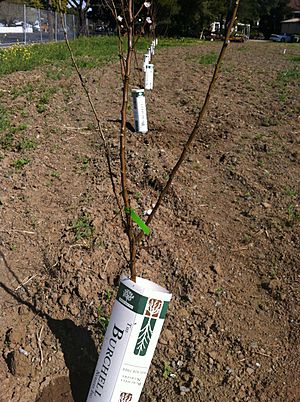
The Dubcich farm on West Campbell Ave. is the last remaining farm in Campbell. It shows the city's farming past. It still has its original farmhouse from the 1920s, a barn, and fruit trees.
Sports and Baseball History
For many years, Campbell had one of the best youth baseball programs in the country. Teams from Campbell reached the Little League World Series 14 times between 1960 and 1987.
Campbell's youth baseball started in 1909. Campbell High School had its first team and won a championship. In 1954, Campbell Little League and Campbell Pony League began.
Moreland Little League, which serves many Campbell residents, won the Little League World Series in 1962. Campbell Little League reached the championship game in 1970, 1976, and 1979. This made them one of only two American leagues to go to the LLWS three times in one decade.
Overall, Campbell-area teams have won six youth baseball World Series. They have also finished second five times. Ten future major league baseball players played in Campbell's youth baseball system.
A book called The Last Baseball Town was written about Campbell's baseball history. It was published in 2009.
Notable People from Campbell
Here are some well-known people who were born, grew up, or lived in Campbell:
- Alan Aerts, a world powerlifting champion
- Dave Meltzer, a wrestling journalist and historian
- Sylvia Browne, a psychic and spiritualist
- Brett Dalton, an actor
- Lars Frederiksen, a musician
- Claire Lobrovich, a baseball player
- Evan Low, a state assemblyman and former mayor
See also
 In Spanish: Campbell (California) para niños
In Spanish: Campbell (California) para niños



